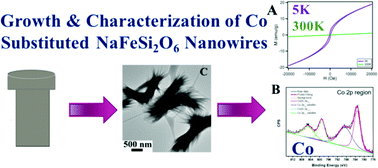Synthesis, characterization, and growth mechanism of motifs of ultrathin cobalt-substituted NaFeSi2O6 nanowires†
Abstract
In this report, we have synthesized and structurally characterized nanowire bundles of cobalt-substituted pyroxenes, similar to the crystal structure of aegirine (i.e. Co-substituted XYSi2O6 with X and Y referring to metallic elements such as but not limited to Co, Na, and Fe), using a readily scalable hydrothermal technique. We propose a growth mechanism for these bundles, based on detailed time and temperature dependent studies as well as complementary control experiments, particularly reactions in the absence of either 3-aminopropyltriethoxysilane (APTES) or sodium hydroxide (NaOH), via a transmission electron microscopy visualization study. Moreover, these nanowire bundles were probed for their magnetic properties and chemical composition using superconducting quantum interference device (SQUID) measurements, X-ray diffraction, and pair distribution function analysis, respectively. Specifically, SQUID measurement observations highlighted that these bundles evince (i) unique and interesting super-paramagnetic properties at 5 K that are consistent with that of our previously published ∼2 nm ultra-small nanoparticles as well as (ii) paramagnetic behavior at 300 K.



 Please wait while we load your content...
Please wait while we load your content...